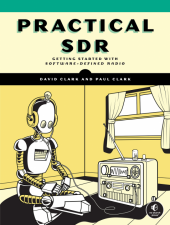Download Chapter 4: Creating an AM Receiver
Look Inside!
Whether you’re a hobbyist interested in exploring the airwaves, a student learning about wireless communications, or an engineer looking to prototype RF designs, Practical SDR will help you master the fundamentals of software-defined radio.
You’ll build virtual radio receivers on your computer, then extract audio from real AM and FM signals; learn how amplitude modulation works by building an AM radio; understand signal filtering by crafting clean FM reception; and grasp complex topics like IQ sampling. You’ll use the intuitive GNU Radio Companion interface to create working radio systems piece by piece, then move on to building functional AM and FM receivers, and even design your own radio transmitter.
Along the way, you’ll learn how to:
• Manipulate radio frequencies from 1 MHz to 6 GHz
• Use filters and gain control to extract clear signals from noise
• Maximize your SDR’s performance by choosing the right antennas and RF hardware
• Process complex, real-time IQ data to demodulate actual radio signals
• Build a flexible, virtual radio testing environment on your computer
This isn’t just another theory book. Practical SDR bridges the gap between basic tutorials and advanced applications, providing a solid foundation for diving into modern wireless systems like Wi-Fi, Bluetooth, and cellular communications.
Some projects require SDR hardware, such as a HackRF One, and a compatible antenna.

